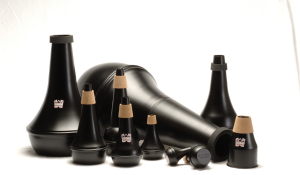A Practical Aid to Beautiful Sound

.png?width=212&height=212&name=Denis%20Wick%20(1).png)
As every teacher knows, a good tone on any brass instrument needs a properly set-up embouchure; these days one may assume that the young player will have a reasonable instrument and a sensible mouthpiece. To this one could add what many teachers would regard as the most important of all – good breath control.
One aspect of the brass-blowing body-machine which is hardly ever emphasized enough is the throat. By opening the throat area, or closing it, the tone-quality can be varied enormously. Although the differences are not quite as much as in singing, they can easily be heard, on any brass instrument. It remains a problem, however, to put across to the young player the concept of “open your throat!” Many ideas like “swallowing a football”, “yawning outwards” or “cooling a hot potato” can work to a greater or (usually) lesser degree, but the use of a Denis Wick practice mute can very easily solve the tight throat problem and also dramatically improve breath-control.
The difficulty that youngsters have with breathing well, often stems from the fact that they are hardly ever allowed to play a maximum ff, and for good reason, nobody practices loudly! Trying to breathe well through a tight throat is fairly impossible anyway, so what one often hears is poor breath support and a rather choked sound.
Try the following:
1) The “Before” Test
(Remember exactly how this sounds) Play mp the first 5 notes of the scale of F (In treble clef the scale of G (second line)) just mp, remember!
2) Play, with the practice mute inserted, low Bb (C) loudly.
Take a deep breath, holding shoulders down, play louder. The note becomes less controlled with increasing volume. Try again, much louder. You will notice, as the volume increases, a “buzz” or rattle from the end of the mute. This “buzz” wobbles and fluctuates. Keep trying to play even louder, make sure that the “wobbles” become more level. Breathe as deeply as possible. Push the air through in a controlled way. Keep increasing the volume. If you begin to feel slightly dizzy, that is quite normal (Hyperoxygenation). Now, with the same or more volume, play a semitone lower gradually progressively descending a semitone at a time, until you are playing the loudest low E (F#) you have ever heard, continuing to breath as deeply as possible. I always describe this as the brass-player’s equivalent of weight lifting.
Get our newest tips, updates, videos, clinics, community events, and more by joining Denis Wick Tips Blog
3) Take out the practice mute
Take a really deep breath and play the “before” test again, (only mp, remember)
4) Listen to the difference in sound
It should now be much more open and rich in tone, as the throat is automatically held open at the pharynx, thus creating extra resonance space.
Each day try this exercise for 15 minutes. After a few weeks, it should be possible to remember the “open throat” feeling, which now happens automatically when breathing in. It can easily be reproduced for all loud playing, especially in the lower register; it can and should also be used for soft playing in middle and upper registers. At all dynamics, espressivo solos can have a whole new dimension!
Although there are now many different practice mutes available, many of the metal models play too sharp (check with a tuner!). The fiber or cardboard types obviously cannot resonate properly at ff levels. The choice of a Denis Wick practice mute helps create this minor miracle in a way that no others can.
---
Formerly the principal trombonist of the London Symphony Orchestra, Denis Wick is internationally recognized as a trombonist and teacher. In 1968 he began making brass mouthpieces and mutes and a company was born.

Find all our Denis Wick resources in one spot on the Denis Wick app. Download to view videos, clinics, educator resources, podcasts, product information & more!



